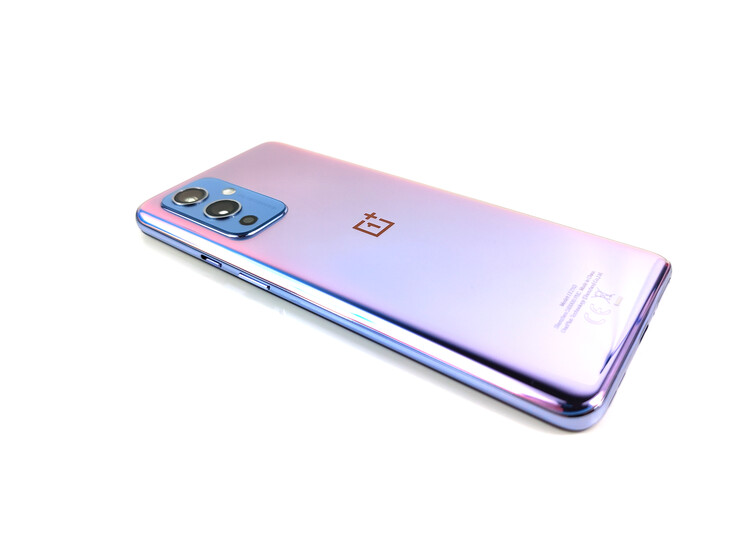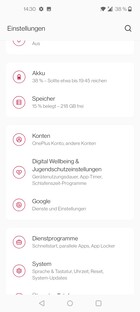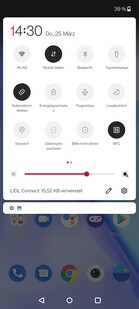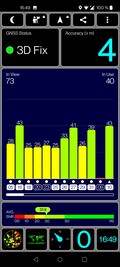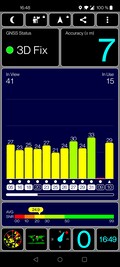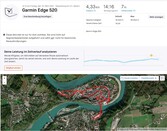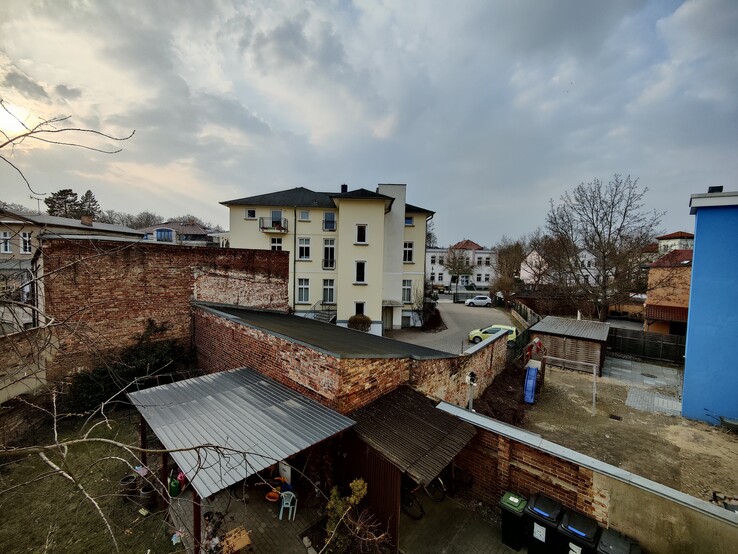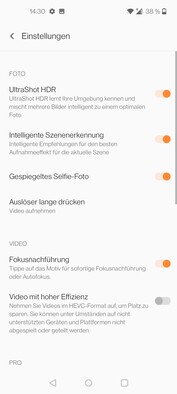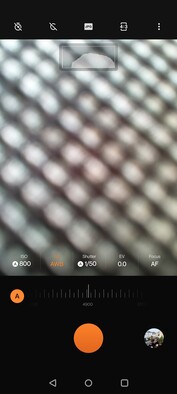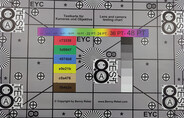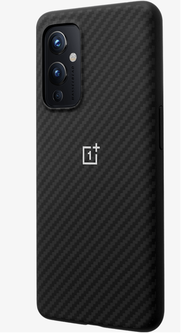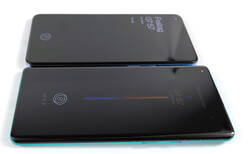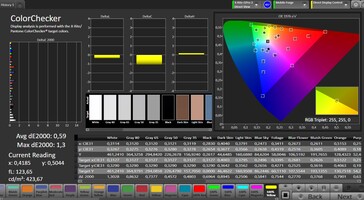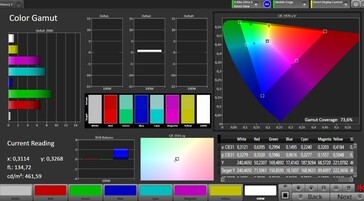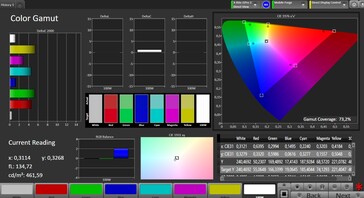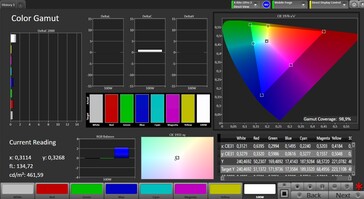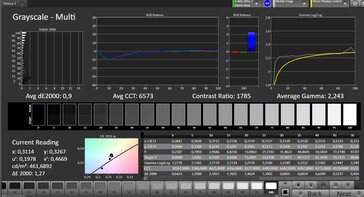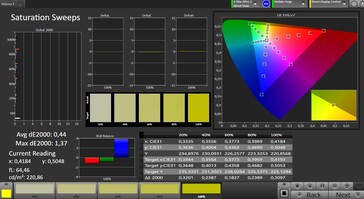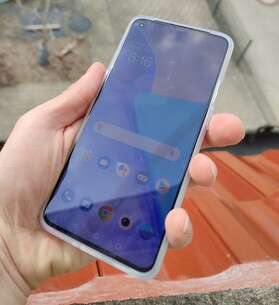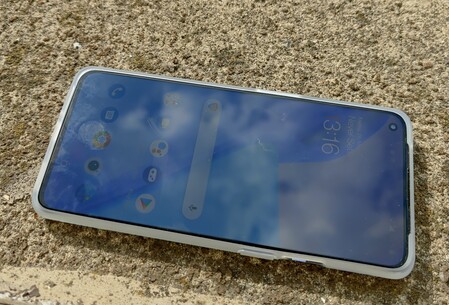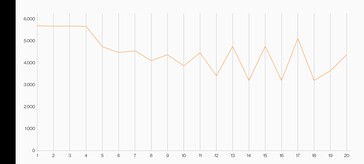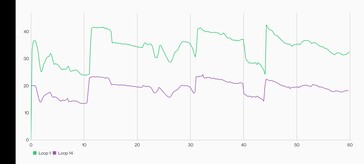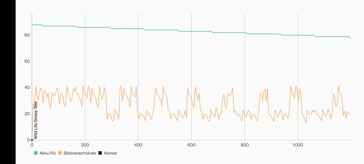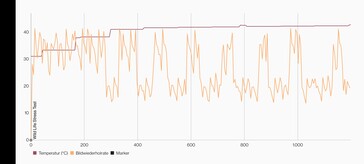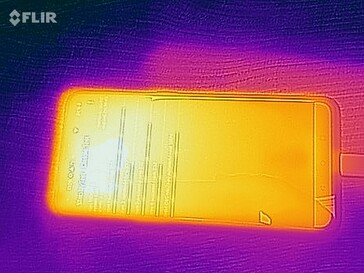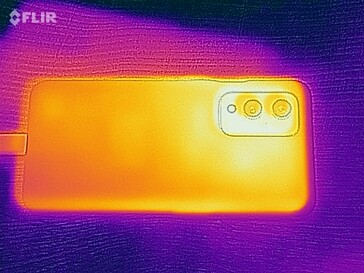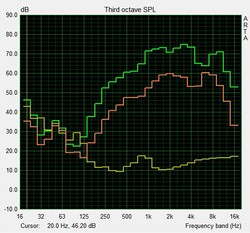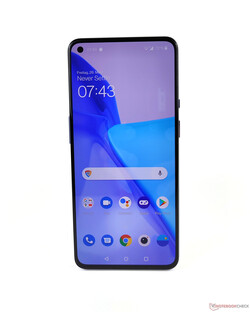OnePlus 9 smartphone review: Strong OnePlus phone without major progress

After Xiaomi introduced the Mi 11 as the cheapest entry into the 2021 flagship series, OnePlus now follows suit with the 9 model. The OnePlus 9 is quite a bit cheaper than its big brother, but it still offers an interesting technical configuration. The following models are available:
OnePlus 9 (128 GB storage/8 GB RAM): 699 Euros (~$822)
OnePlus 9 (256 GB storage/12 GB RAM): 799 Euros (~$940)
The premium smartphone uses a 6.55-inch OLED panel with a native refresh rate of 120 Hz. Like this year's Pro model, the OnePlus 9 makes use of a Hasselblad-branded, rear-facing camera setup as well as a 16 MP front-facing camera integrated into the punch hole.
The OnePlus 9 will be available in Germany starting April 26. Naturally, the question is whether it is worth investing at least 699 Euros (~$822) in the 2021 model. Our review will clarify this.
Possible contenders in comparison
Rating | Date | Model | Weight | Drive | Size | Resolution | Price |
|---|---|---|---|---|---|---|---|
| 87.2 % v7 (old) | 04 / 2021 | OnePlus 9 SD 888 5G, Adreno 660 | 192 g | 256 GB UFS 3.1 Flash | 6.55" | 2400x1080 | |
| 87.8 % v7 (old) | 10 / 2020 | OnePlus 8T SD 865, Adreno 650 | 188 g | 128 GB UFS 3.1 Flash | 6.55" | 2400x1080 | |
| 87.3 % v7 (old) | 02 / 2021 | Xiaomi Mi 11 SD 888 5G, Adreno 660 | 196 g | 128 GB UFS 3.1 Flash | 6.81" | 3200x1440 | |
| 89.6 % v7 (old) | 02 / 2021 | Samsung Galaxy S21+ Exynos 2100 5G, Mali-G78 MP14 | 200 g | 128 GB UFS 3.1 Flash | 6.70" | 2400x1080 | |
| 84.6 % v7 (old) | 10 / 2020 | Google Pixel 5 SD 765G, Adreno 620 | 151 g | 128 GB UFS 2.1 Flash | 6.00" | 2340x1080 | |
| 88.6 % v7 (old) | 06 / 2022 | OnePlus 9 Pro SD 888 5G, Adreno 660 | 197 g | 256 GB UFS 3.1 Flash | 6.70" | 3216x1440 |
Case - OnePlus 9 with punch hole
Three different color options are available for the OnePlus 9: Winter Mist, Arctic Sky, and Astral Black. The latter have a matte back made of Gorilla Glass 5 and look quite stylish, in our opinion. Our review sample in Winter Mist is also "matte" in the area of the camera module, while the lower part of the case acts more like a mirror. Due to the matte finish below the glass, fingerprints are naturally much less present in the upper area than in the section belonging to the lower third with its high-gloss look.
The slightly curved glass panel on the back feels comfortable in the hand. Overall, the build quality and feel are at a very high level, although the frame was probably only made of plastic and not metal, which is also quite perceptible. The built-in buttons sit firmly in the frame as well, and the pressure points are pleasantly firm. The OnePlus-typical alert slider is also on board again.
In contrast to the Pro model, the Gorilla Glass on the front is flat. Whether you like that or not is a matter of taste. However, a negative consequence of the flat design are the bezels on the top and bottom of the 6.55-inch display. Although they are relatively thin, they are not as thin as on the Xiaomi Mi 11, for example. This only results in a good screen-to-body ratio of 87.5%.
The case of the OnePlus 9 lacks an official IP certification. However, an inquiry to our provider confirmed that the OnePlus 9 also has the same seals as the OnePlus 9 Pro, which means that (theoretically) not only the Pro model is water-resistant. However, the OnePlus 9 was not officially certified.
Connectivity - OnePlus smartphone with USB 3.1
The OnePlus 9's features include an in-display fingerprint sensor, dual SIM, and USB OTG for fast connection of external accessories. The wireless image transmission of screen content (Miracast) also works without problems in our test. A USB Type-C port that supports the USB 3.1 Gen. 1 standard is available for wired data transfer. The 4,500 mAh battery is also charged via the USB-C port on the case's bottom using Warp Charge 65T.
The internal UFS storage in our review sample has a capacity of 256 GB, but the user only has 221 GB available out of the box. It's not possible to expand the OnePlus 9's storage.
The OnePlus 9's Camera2 API is available at Level 3, and streaming content can be viewed in HD quality thanks to DRM Widevine L1.
Software - OnePlus phone with Android 11
The OnePlus 9 comes with Android 11 and the OxygenOS software interface out of the box. In version 11, the in-house UI comes with a new Turbo Boost 3.0 memory optimization feature that is supposed to keep more apps active in the background through RAM compression and virtual RAM, which converts phone storage into RAM.
OnePlus offers a clean and well-optimized operating system with OxygenOS 11. Apart from Google apps, only Netflix is preinstalled as a third-party app. The interface offers many configuration options, but it's lacking a one-hand mode.
During our testing, our OnePlus 9 runs OxygenOS version 11.2.11 with security patches at the level of February 2021.
Communication and GPS - OnePlus 9 with 5G
With Wi-Fi 6 and multi-user MIMO, the OnePlus 9 offers a very good configuration for the home Wi-Fi network, which ensures high transfer rates in our measurements. In combination with our Netgear Nighthawk AX12 reference router, the OnePlus phone is also quite consistent. However, the average rate for sending data is "only" about 685 Mb/s, which is still good, but the OnePlus 8T performed better in our test.
In terms of communication modules, the OnePlus 9 also uses dual SIM, 5G, and NFC for near-field communication. While the Snapdragon 865 in the OnePlus 8T still relied on a separate 5G modem, the chipset in the 2021 model has integrated the new X60 modem RF system based on a 5-nanometer manufacturing process. This also enables the Bluetooth 5.2 functionality that the OnePlus 9 has.
Besides the 5G standard, the premium smartphone from OnePlus supports access to a total of 22 LTE bands - all LTE frequencies relevant to Germany, including LTE band 20 and band 28, are covered.
| Networking | |
| iperf3 transmit AX12 | |
| Samsung Galaxy S21+ | |
| Samsung Galaxy S21+ | |
| OnePlus 8T | |
| OnePlus 9 | |
| OnePlus 9 Pro | |
| Xiaomi Mi 11 | |
| Google Pixel 5 | |
| iperf3 receive AX12 | |
| Samsung Galaxy S21+ | |
| Samsung Galaxy S21+ | |
| Xiaomi Mi 11 | |
| OnePlus 9 Pro | |
| OnePlus 9 | |
| OnePlus 8T | |
| Google Pixel 5 | |
In order to assess the positioning accuracy in practice, we take the OnePlus 9 on a short trip and simultaneously track the route with a Garmin Edge 520 for comparison purposes. There are only 50 meters between the smartphone's GPS module and the navigation device at the end of the approximately 4.5-kilometer test route. Therefore, the deviations are small, and if you look at the detailed view of the GPS log, the OnePlus phone hardly shows any noteworthy inaccuracies in the route.
The OnePlus 9 uses the following main satellite systems for positioning: GPS (L1+L5), GLONASS, BeiDou, and Galileo (E1+E5a). Positioning is fast with an accuracy of 4 meters. Even indoors, the location is determined quite quickly but a bit less accurately.
Telephone and call quality - OnePlus 9 with VoLTE
The OnePlus 9 has good call quality. However, voices are reproduced a bit quietly and also sound muffled in speaker mode. Video calls via the built-in front-facing camera work smoothly as well. Call quality using the two built-in microphones enables good communication via Skype in our test.
Like its predecessor, the high-end phone supports dual SIM with two physical SIM cards - an eSIM can't be used. However, features like WLAN calling and VoLTE are supported.
Cameras - OnePlus smartphone with triple-camera setup
The Chinese manufacturer expects to have taken a big step forward with the camera modules. With the OnePlus 9, the focus is particularly placed on the ultra wide-angle camera, since the new Sony sensor is used here, just like in the Pro model. The 1/1.56-inch IMX766 has a "freeform" lens that is supposed to be able to reduce distortions around the edges to about one percent.
In practice, the ultra wide-angle module delivers very good results, especially considering the MSRP of under 700 Euros (~$823). Photos taken with the 50 MP sensor score points with a good dynamic range and appealing sharpness. Even in the peripheral areas, blurring is only slightly pronounced. However, the 50 MP lens has problems with lighting in the dark, and the noise level increases quickly too. Furthermore, the ultra wide-angle camera can capture macro pictures with solid quality.
The 48 MP main camera in the OnePlus 9 is based on a familiar Sony sensor, the IMX689. The latter already delivers good to very good results in daylight in the OnePlus 8 Pro - the same is true for the 2021 model. However, the OnePlus 9 also shows shortcomings in terms of image sharpness in low-light conditions if not earlier. In addition, the camera's lens as well as the wide-angle lens only use EIS.
The main and wide-angle cameras of the OnePlus 9 can now also record videos in 8K at 30 fps. However, those who want to use a higher frame rate will still have to settle for Ultra HD (up to 60 FPS). A special low-light mode is also available through Nightscape Video 2.0, but only in 1080p at 30 fps. It's possible to switch between the two lenses during an ongoing video recording, but subjects are displayed much cooler with the main camera.
Besides the Night Mode for videos, the OnePlus 9 also has a Tilt Shift mode as well as a Hasselblad Pro mode that features sensor calibration, manual ISO, and exposure time, among other things. In addition, much larger color depth is possible thanks to 12-bit RAW photos.
The 16 MP front-facing camera equipped with the Sony IMX471 takes decent selfies. However, we would prefer the photos to have more sharpness and contrast. We would also like to see a UHD option for video recording.
Image comparison
Choose a scene and navigate within the first image. One click changes the position on touchscreens. One click on the zoomed-in image opens the original in a new window. The first image shows the scaled photograph of the test device.
Main cameraLow lightWide angleWe subject the OnePlus 9's rear-facing main camera to further tests under controlled lighting conditions. We use the ColorChecker Passport to analyze the color reproduction of the 48 MP lens in comparison to the actual reference colors. We take measurements once under full studio lighting and another time at 1 lux light intensity.
The colors are well reproduced by the premium smartphone, and there are no real weaknesses. However, the Chinese manufacturer advertises its photo quality as having "incredibly authentic colors" - but the ColorChecker's deviations are a bit too high for that. Compared with the reference colors, you can also see the typical smartphone brightening effect.
The image sharpness in our test chart is at a good level. However, the image's peripheral areas aren't entirely sharp.
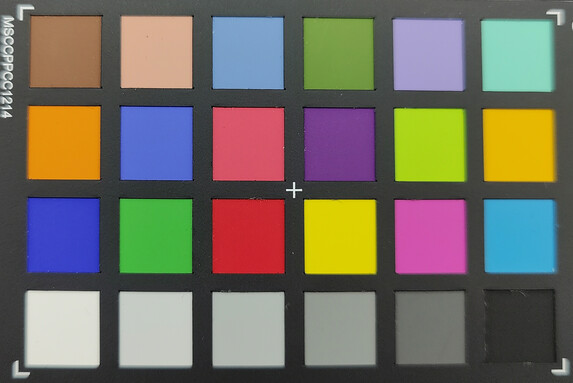

Accessories and warranty - OnePlus 9 with 65-watt power adapter
The OnePlus 9 comes with a red USB cable with white connectors (USB-C to USB-C), a 65-watt Warp Charge modular power adapter, a screen protector, and a SIM tray ejector. A silicon bumper case is also on board out of the box.
In addition, OnePlus also offers optional accessories this year. These include bumper cases with carbon and sandstone finishes, a 3D tempered glass screen protector, and a Warp Charge 50 wireless charger. The prices for these start at about 25 Euros (~$29).
The Chinese manufacturer offers its smartphone with a 24-month warranty.
Input devices and handling - OnePlus smartphone with 120 Hz
OnePlus has installed a new vibration motor in its high-end phone that provides nice haptic feedback. As a result, typing on the OnePlus 9 is very pleasant. However, the vibrations are much less powerful than in the Pro model.
However, not only does operation benefit from the good vibration motor but also from the high refresh rate of 120 Hz as well as the sampling rate of 360 Hz. This means that the capacitive multi-touchscreen is monitored for taps up to 360 times per second (e.g. in games). The OnePlus 9 can be operated with corresponding accuracy.
The optical fingerprint sensor underneath the display of the OnePlus 9 responds quickly and usually detects fingers precisely. However, its placement is very low and, therefore, a bit uncomfortable. Users who want to use facial data to unlock the display can do so via the front-facing camera. However, using your face for biometric identification is not very secure due to the 2D technology.
Display - OnePlus 9 with 1080p OLED panel
While OnePlus uses WQHD+ for the resolution of its flagship smartphones, the smaller model still has to make do with 1080p. Whether every user needs the 3216x1440 pixels remains to be seen, but digital content isn't displayed as sharply on the OnePlus 9 as it is on the Pro model. The refresh rate of 120 Hz is at flagship level, but the premium phone doesn't have an adaptive refresh rate, which means that either 120 Hz or the "normal" 60 Hz can be used. The switch is performed automatically (depending on the app) to save battery power.
The 6.55-inch AMOLED display achieves a high brightness of 758 cd/m² with a homogeneous brightness distribution in our measurements. We also check brightness with an evenly distributed ratio of dark to bright areas (APL50) in the test. Here, we can also determine a high brightness of 914 cd/m², which should be sufficient for HDR content. However, the Xiaomi Mi 11 offers over 200 cd/m² more in this discipline. And compared with the predecessor, things are rather stagnant here as well.
The OnePlus 9 uses pulse width modulation (PWM) at a high frequency of 324 Hz for brightness control.
| |||||||||||||||||||||||||
Brightness Distribution: 96 %
Center on Battery: 731 cd/m²
Contrast: ∞:1 (Black: 0 cd/m²)
ΔE ColorChecker Calman: 0.59 | ∀{0.5-29.43 Ø4.79}
ΔE Greyscale Calman: 0.9 | ∀{0.09-98 Ø5}
98.9% sRGB (Calman 2D)
Gamma: 2.243
CCT: 6573 K
| OnePlus 9 AMOLED, 2400x1080, 6.6" | OnePlus 8T AMOLED, 2400x1080, 6.6" | Xiaomi Mi 11 LED DotDisplay, 3200x1440, 6.8" | Samsung Galaxy S21+ Dynamic AMOLED 2X, 2400x1080, 6.7" | Google Pixel 5 OLED, 2340x1080, 6" | OnePlus 9 Pro AMOLED, 3216x1440, 6.7" | |
|---|---|---|---|---|---|---|
| Screen | -24% | -50% | -75% | -37% | -34% | |
| Brightness middle (cd/m²) | 731 | 743 2% | 840 15% | 814 11% | 635 -13% | 733 0% |
| Brightness (cd/m²) | 739 | 734 -1% | 845 14% | 814 10% | 636 -14% | 746 1% |
| Brightness Distribution (%) | 96 | 91 -5% | 98 2% | 97 1% | 97 1% | 97 1% |
| Black Level * (cd/m²) | ||||||
| Colorchecker dE 2000 * | 0.59 | 0.89 -51% | 1.2 -103% | 2 -239% | 0.8 -36% | 0.95 -61% |
| Colorchecker dE 2000 max. * | 1.3 | 1.69 -30% | 2.7 -108% | 3.6 -177% | 2.2 -69% | 2.01 -55% |
| Greyscale dE 2000 * | 0.9 | 1.4 -56% | 2 -122% | 1.4 -56% | 1.7 -89% | 1.7 -89% |
| Gamma | 2.243 98% | 2.199 100% | 2.26 97% | 2.12 104% | 2.23 99% | 2.21 100% |
| CCT | 6573 99% | 6423 101% | 6492 100% | 6568 99% | 6492 100% | 6591 99% |
* ... smaller is better
Screen Flickering / PWM (Pulse-Width Modulation)
| Screen flickering / PWM detected | 323.6 Hz | |
The display backlight flickers at 323.6 Hz (worst case, e.g., utilizing PWM) . The frequency of 323.6 Hz is relatively high, so most users sensitive to PWM should not notice any flickering. However, there are reports that some users are still sensitive to PWM at 500 Hz and above, so be aware. In comparison: 53 % of all tested devices do not use PWM to dim the display. If PWM was detected, an average of 8152 (minimum: 5 - maximum: 343500) Hz was measured. | ||
As in the 8T, OnePlus uses an AMOLED display in which individual pixels can be completely turned off, resulting in "absolute" blacks. This means that contrast theoretically tends to infinity and that buyers shouldn't have any concerns in this regard. In our tests with the CalMAN software and a spectrophotometer, we found that the display of the OnePlus smartphone is very well calibrated, and it delivers very low color deviations (in the Natural profile).
Display Response Times
| ↔ Response Time Black to White | ||
|---|---|---|
| 6 ms ... rise ↗ and fall ↘ combined | ↗ 3 ms rise | |
| ↘ 3 ms fall | ||
| The screen shows very fast response rates in our tests and should be very well suited for fast-paced gaming. In comparison, all tested devices range from 0.1 (minimum) to 240 (maximum) ms. » 17 % of all devices are better. This means that the measured response time is better than the average of all tested devices (20.3 ms). | ||
| ↔ Response Time 50% Grey to 80% Grey | ||
| 20 ms ... rise ↗ and fall ↘ combined | ↗ 11 ms rise | |
| ↘ 9 ms fall | ||
| The screen shows good response rates in our tests, but may be too slow for competitive gamers. In comparison, all tested devices range from 0.165 (minimum) to 636 (maximum) ms. » 31 % of all devices are better. This means that the measured response time is better than the average of all tested devices (31.7 ms). | ||
Daylight doesn't pose any issues for the OnePlus 9. The premium smartphone is optimally equipped for everyday outdoor use. In direct sunlight and with the accompanying reflections on the glass surface, however, differences compared to current flagship panels that reach well over 1000 nits are noticeable.
Viewing angles are very good thanks to the built-in OLED technology. Even at very flat viewing angles, content on the screen is displayed vividly and with accurate colors.
Performance - OnePlus 9 with the Snapdragon 888
The latest high-end chipset from Qualcomm that is installed in the OnePlus 9 is based on the new Kryo 680 CPU unit. It integrates a fast "Prime Core" that is based on the ARM Cortex-X1 architecture and runs at up to 2.84 GHz, three fast Cortex A78-based performance cores (2.42 GHz), and four ARM Cortex-A55 cores with a maximum clock rate of 1.8 GHz. Besides the CPU unit, the chipset has a Qualcomm Adreno 660 as the GPU as well as a Hexagon 780 computing unit and Qualcomm Sensing Hub for AI applications.
The Snapdragon 888 also reveals its great performance potential in the OnePlus 9 in our benchmark package. In contrast to the Xiaomi Mi 11, where the benchmarks sometimes crashed due to overheating protection, the tests run without problems on the OnePlus phone. However, the Chinese manufacturer only allows its premium phone to run at 60 Hz in GFX Bench as well - despite selecting 120 Hz in the settings menu. And benchmarks such as the UL Procyon AI Inference test result in comparatively low scores too.
However, the OnePlus 9 runs very smoothly and almost without lags in everyday use. The system performance is first-rate, and the application loading times are very fast. This is also due to the fast read and write speeds of the UFS storage. However, these are relatively low for the 3.1 standard considering that the Snapdragon 888 should (theoretically) support the full bandwidth.
| PCMark for Android | |
| Work performance score (sort by value) | |
| OnePlus 9 | |
| OnePlus 8T | |
| Xiaomi Mi 11 | |
| Samsung Galaxy S21+ | |
| Google Pixel 5 | |
| OnePlus 9 Pro | |
| Average Qualcomm Snapdragon 888 5G (11823 - 18942, n=7) | |
| Work 2.0 performance score (sort by value) | |
| OnePlus 9 | |
| OnePlus 8T | |
| Xiaomi Mi 11 | |
| Samsung Galaxy S21+ | |
| Google Pixel 5 | |
| OnePlus 9 Pro | |
| Average Qualcomm Snapdragon 888 5G (10231 - 15027, n=10) | |
| AnTuTu v8 - Total Score (sort by value) | |
| OnePlus 9 | |
| OnePlus 8T | |
| Xiaomi Mi 11 | |
| Samsung Galaxy S21+ | |
| Google Pixel 5 | |
| OnePlus 9 Pro | |
| Average Qualcomm Snapdragon 888 5G (569595 - 740847, n=12) | |
| AImark - Score v2.x (sort by value) | |
| OnePlus 9 | |
| Xiaomi Mi 11 | |
| Samsung Galaxy S21+ | |
| Average Qualcomm Snapdragon 888 5G (171404 - 264766, n=15) | |
| UL Procyon AI Inference for Android - Overall Score NNAPI (sort by value) | |
| OnePlus 9 | |
| Xiaomi Mi 11 | |
| Average Qualcomm Snapdragon 888 5G (9372 - 32288, n=6) | |
| Average of class Smartphone (3769 - 81594, n=139, last 2 years) | |
| Jetstream 2 - 2.0 Total Score | |
| Average of class Smartphone (23.8 - 387, n=156, last 2 years) | |
| Average Qualcomm Snapdragon 888 5G (61.3 - 125.1, n=13) | |
| Xiaomi Mi 11 (Chrome 88) | |
| OnePlus 8T (Chrome 86) | |
| Samsung Galaxy S21+ (Chrome 88.0.4324.152) | |
| OnePlus 9 Pro (Microsoft Edge 46) | |
| OnePlus 9 (MS Edge) | |
| Google Pixel 5 (Chrome 86.0.4240.110) | |
| JetStream 1.1 - Total Score | |
| Average Qualcomm Snapdragon 888 5G (77 - 223, n=19) | |
| Xiaomi Mi 11 (Chrome 88) | |
| OnePlus 9 Pro (Microsoft Edge 46) | |
| OnePlus 9 (MS Edge) | |
| OnePlus 8T (Chrome 86) | |
| Samsung Galaxy S21+ (Chrome 88.0.4324.152) | |
| Google Pixel 5 (Chrome 86.0.4240.110) | |
| Speedometer 2.0 - Result 2.0 | |
| Average of class Smartphone (15.2 - 643, n=132, last 2 years) | |
| Samsung Galaxy S21+ (Chrome 88.0.4324.152) | |
| Average Qualcomm Snapdragon 888 5G (46.9 - 121, n=12) | |
| OnePlus 8T (Chome 86) | |
| Xiaomi Mi 11 (Chrome 88) | |
| OnePlus 9 Pro (Microsoft Edge 46) | |
| OnePlus 9 (MS Edge) | |
| Google Pixel 5 (Chrome 86.0.4240.110) | |
| WebXPRT 3 - Overall | |
| Average of class Smartphone (38 - 380, n=41, last 2 years) | |
| Average Qualcomm Snapdragon 888 5G (103 - 182, n=18) | |
| Xiaomi Mi 11 (Chrome 88) | |
| OnePlus 9 (MS Edge) | |
| OnePlus 8T (Chrome 86) | |
| OnePlus 9 Pro (Microsoft Edge 4689) | |
| Samsung Galaxy S21+ (Chrome 88.0.4324.152) | |
| Google Pixel 5 (Chrome 86.0.4240.110) | |
| Octane V2 - Total Score | |
| Average of class Smartphone (2228 - 121337, n=202, last 2 years) | |
| Average Qualcomm Snapdragon 888 5G (23491 - 47543, n=20) | |
| Samsung Galaxy S21+ (Chrome 88.0.4324.152) | |
| Xiaomi Mi 11 (Chrome 88) | |
| OnePlus 9 Pro (Microsoft Edge 46) | |
| OnePlus 9 (Chrome89) | |
| OnePlus 8T (Chrome 86) | |
| Google Pixel 5 (Chrome 86.0.4240.110) | |
| Mozilla Kraken 1.1 - Total | |
| Google Pixel 5 (Chrome 86.0.4240.110) | |
| OnePlus 8T (Chrome 86) | |
| OnePlus 9 Pro (Microsoft Edge 46) | |
| Samsung Galaxy S21+ (Chrome 88.0.4324.152) | |
| Xiaomi Mi 11 (Chrome 88) | |
| OnePlus 9 (Chrome89) | |
| Average Qualcomm Snapdragon 888 5G (891 - 1841, n=20) | |
| Average of class Smartphone (257 - 28190, n=157, last 2 years) | |
* ... smaller is better
| OnePlus 9 | OnePlus 8T | Xiaomi Mi 11 | Samsung Galaxy S21+ | Google Pixel 5 | OnePlus 9 Pro | Average 256 GB UFS 3.1 Flash | Average of class Smartphone | |
|---|---|---|---|---|---|---|---|---|
| AndroBench 3-5 | -25% | 11% | 23% | -49% | 10% | 32% | 62% | |
| Sequential Read 256KB (MB/s) | 1872 | 1659 -11% | 1615 -14% | 1623 -13% | 851 -55% | 1995 7% | 1757 ? -6% | 2211 ? 18% |
| Sequential Write 256KB (MB/s) | 739 | 728 -1% | 754 2% | 1037 40% | 190 -74% | 769 4% | 1204 ? 63% | 1827 ? 147% |
| Random Read 4KB (MB/s) | 225.4 | 132.6 -41% | 278.5 24% | 309.6 37% | 138.9 -38% | 258.7 15% | 287 ? 27% | 294 ? 30% |
| Random Write 4KB (MB/s) | 221.4 | 121.4 -45% | 289.3 31% | 283.3 28% | 155.9 -30% | 254.3 15% | 318 ? 44% | 337 ? 52% |
Games - OnePlus 9 only hits 60 fps
We take a closer look at the OnePlus 9's gaming performance with our partner GameBench using demanding game titles from the Play Store. For this purpose, the Chinese manufacturer provides a new Pro Gaming Mode that pauses notifications and adjusts the SoC's performance to the respective game. However, this mode is still called Fnatic Mode (at least in the current software version).
The PUBG Mobile shooter, where the Ultra HD setting can be selected, is rendered smoothly at 40 fps even at maximum details. However, the OLED panel's full 120 Hz is neither available at high nor low graphics settings. The high-end phone manages a maximum of 60 fps here. The CPU-intensive racing game Asphalt 9 Legends isn't able to exceed the 60 fps limit, either. Our measurements don't show any visible frame-rate drops.
Emissions - OnePlus smartphone with high heat development
Temperature
The high heat development of the Snapdragon 888 is handled better by the proprietary Cool Play cooling system, which is supposed to ensure heat dissipation even during intensive gaming by means of a vapor chamber and layers of graphite and copper. We experienced the problem of the system overheating under prolonged load with the Xiaomi Mi 11. That doesn't happen with the high-end phone from OnePlus. Nevertheless, the OnePlus 9 also gets quite hot under prolonged load. We measure a maximum value of almost 46 °C (~115 °F). In idle usage, however, the temperature increase is completely within limits and doesn't cause any problems.
The premium phone from OnePlus also completes the GFXBench battery test without issues in the demanding Manhattan test (OpenGL ES 3.1). The Wild Life stability stress test runs smoothly as well, but it's surprisingly inconsistent. The OnePlus 9 throttles by nearly 50% here, but the case's heat is kept within limits.
| 3DMark - Wild Life Stress Test Stability | |
| Google Pixel 5 | |
| Xiaomi Mi 11 | |
| Samsung Galaxy S21+ | |
| OnePlus 9 Pro | |
| OnePlus 9 | |
(-) The maximum temperature on the upper side is 45.6 °C / 114 F, compared to the average of 35.2 °C / 95 F, ranging from 21.9 to 247 °C for the class Smartphone.
(±) The bottom heats up to a maximum of 41.5 °C / 107 F, compared to the average of 34 °C / 93 F
(+) In idle usage, the average temperature for the upper side is 24.8 °C / 77 F, compared to the device average of 32.9 °C / 91 F.
Speakers
The OnePlus 9 uses two speakers, one of which is located in the auricle area and the other on the case's bottom edge. The Dolby Atmos certified system gets sufficiently loud at 83 d(B), but this still isn't very loud. We like the sound experience, even if the low sound ranges are reproduced a bit too thinly. In addition, the super high tones clearly take a nosedive.
The premium phone doesn't offer an audio jack, and OnePlus doesn't include an adapter for the USB port. Bluetooth can be used for wireless media playback, and the audio codecs SBC, AAC, aptX, aptX HD, and LDAC are supported. The LHDC codec still can't be used with the OnePlus 9.
OnePlus 9 audio analysis
(+) | speakers can play relatively loud (83 dB)
Bass 100 - 315 Hz
(-) | nearly no bass - on average 68.3% lower than median
(+) | bass is linear (0% delta to prev. frequency)
Mids 400 - 2000 Hz
(-) | nearly no mids - on average 68.3% lower than median
(+) | mids are linear (0% delta to prev. frequency)
Highs 2 - 16 kHz
(-) | nearly no highs - on average 68.3% lower than median
(+) | highs are linear (0% delta to prev. frequency)
Overall 100 - 16.000 Hz
(-) | overall sound is not linear (117.1% difference to median)
Compared to same class
» 87% of all tested devices in this class were better, 6% similar, 6% worse
» The best had a delta of 11%, average was 35%, worst was 134%
Compared to all devices tested
» 96% of all tested devices were better, 2% similar, 2% worse
» The best had a delta of 4%, average was 24%, worst was 134%
Xiaomi Mi 11 audio analysis
(+) | speakers can play relatively loud (86.8 dB)
Bass 100 - 315 Hz
(-) | nearly no bass - on average 26% lower than median
(±) | linearity of bass is average (9.5% delta to prev. frequency)
Mids 400 - 2000 Hz
(+) | balanced mids - only 4.5% away from median
(+) | mids are linear (5.3% delta to prev. frequency)
Highs 2 - 16 kHz
(+) | balanced highs - only 4.5% away from median
(+) | highs are linear (2.3% delta to prev. frequency)
Overall 100 - 16.000 Hz
(±) | linearity of overall sound is average (17.8% difference to median)
Compared to same class
» 14% of all tested devices in this class were better, 8% similar, 78% worse
» The best had a delta of 11%, average was 35%, worst was 134%
Compared to all devices tested
» 35% of all tested devices were better, 8% similar, 57% worse
» The best had a delta of 4%, average was 24%, worst was 134%
Battery life - OnePlus 9 with dual-cell battery
Energy consumption
The 4,500 mAh dual-cell battery (2x 2,250 mAh) in the OnePlus smartphone can be fully recharged in a good 30 minutes with the included 60-watt Warp Charge power adapter. The European version available in Germany also supports Qi wireless charging at up to 15 watts.
| Off / Standby | |
| Idle | |
| Load |
|
Key:
min: | |
| OnePlus 9 4500 mAh | OnePlus 8T 4500 mAh | Xiaomi Mi 11 4600 mAh | Samsung Galaxy S21+ 4800 mAh | Google Pixel 5 4080 mAh | OnePlus 9 Pro 4500 mAh | Average Qualcomm Snapdragon 888 5G | Average of class Smartphone | |
|---|---|---|---|---|---|---|---|---|
| Power Consumption | 11% | -16% | 18% | 51% | -20% | 7% | 6% | |
| Idle Minimum * (Watt) | 0.9 | 1.1 -22% | 1.57 -74% | 0.74 18% | 0.69 23% | 1.6 -78% | 1.066 ? -18% | 0.853 ? 5% |
| Idle Average * (Watt) | 1.7 | 1.5 12% | 1.92 -13% | 1.27 25% | 0.82 52% | 2 -18% | 1.58 ? 7% | 1.43 ? 16% |
| Idle Maximum * (Watt) | 2.7 | 1.7 37% | 1.94 28% | 1.33 51% | 0.85 69% | 2.4 11% | 1.733 ? 36% | 1.609 ? 40% |
| Load Average * (Watt) | 5.4 | 4.6 15% | 6.32 -17% | 6.32 -17% | 2.73 49% | 6.2 -15% | 5.46 ? -1% | 7.09 ? -31% |
| Load Maximum * (Watt) | 11.1 | 9.4 15% | 11.65 -5% | 9.61 13% | 4.4 60% | 11 1% | 9.79 ? 12% | 11.2 ? -1% |
* ... smaller is better
Battery life
In our Wi-Fi test with an adjusted display brightness of 150 cd/m², the OnePlus 9 lasted a good 14 hours at 120 Hz, which should be enough for a whole day even with heavy use. The battery of the 6.55-inch OLED panel lasted another hour during our continuous video playback with the Wi-Fi module disabled. The battery life of well under 3 hours under full load is a bit disappointing.
| OnePlus 9 4500 mAh | OnePlus 8T 4500 mAh | Xiaomi Mi 11 4600 mAh | Samsung Galaxy S21+ 4800 mAh | Google Pixel 5 4080 mAh | OnePlus 9 Pro 4500 mAh | |
|---|---|---|---|---|---|---|
| Battery runtime | 14% | -9% | 20% | 48% | 38% | |
| Reader / Idle (h) | 27.1 | 25.7 -5% | 19.1 -30% | 29.7 10% | 37.4 38% | 35.2 30% |
| H.264 (h) | 15.5 | 18.4 19% | 16.2 5% | 19.6 26% | 24.4 57% | 17.9 15% |
| WiFi v1.3 (h) | 14.2 | 17.1 20% | 8.8 -38% | 10.9 -23% | 13.5 -5% | 16.7 18% |
| Load (h) | 2.8 | 3.4 21% | 3.6 29% | 4.7 68% | 5.6 100% | 5.3 89% |
Pros
Cons
Verdict on the OnePlus 9 - Premium phone with deducted style points
The OnePlus 9 is a very nice smartphone that convinces with a great OLED display, good battery life, and very smooth performance. However, in our opinion, the premium smartphone lacks a bit of progress within the model series.
Compared with the OnePlus 8T, the entry into the 2021 series now costs 100 Euros (~$118) more, which would certainly be justified by the improved wireless charging and rear-facing cameras. However, the OnePlus 9 still doesn't have an IP rating, and we notice more than just improvements in direct comparison with the predecessor. We find the placement of the fingerprint scanner to be awkward, the frame feels like plastic, and the cameras only have digital image stabilization. In terms of zoom capabilities, the 2021 model still requires compromises due to the lack of a dedicated lens with an equivalently long focal length.
The OnePlus 9 is a great smartphone. However, the OnePlus 8T and its pricing show the successor in a worse light than it should be. Perhaps OnePlus would be better advised to gradually depart from the six-month model update strategy.
Overall, the OnePlus 9 offers a strong package. If you're looking for a premium smartphone, there's no getting around the OnePlus 9 at the moment. Especially in direct comparison with the Xiaomi Mi 11, the recommended retail price of the OnePlus 9 series is still quite attractive this year.
Price and availability
The OnePlus 9 is currently available on Amazon in the version with 8 GB of RAM and 128 GB of storage for $729.99. Alternatively, you can also purchase the device directly from OnePlus on their website.
OnePlus 9
- 08/31/2022 v7 (old)
Marcus Herbrich






